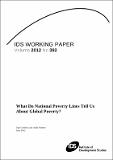| dc.description.abstract | The basic question about ‘how many poor people are there in the world?’ generally assumes
that poverty is measured according to international poverty lines (IPLs). Yet, an equally relevant
question could be ‘how many poor people are there in the world, based on how poverty is
defined where those people live?’ In short, rather than a comparison based on monetary
values, the latter question is germane to estimates based on a concept – ‘poverty’ – as defined
by countries’ specific circumstances and institutions.
Estimates of poverty by national poverty lines (NPLs) and international poverty lines (IPLs) may
vary in terms of technical grounds. But how similar are they? How different is poverty captured
by comparable (in PPP monetary value) cross-country measures as embodied by the IPL
compared to that viewed in NPLs?
This paper offers a new perspective on global poverty. It does so by estimating the distribution
of poverty across countries, regions and income categories based on national poverty lines
(NPLs). Even though comparing NPLs across countries means comparing poverty lines of
different monetary value, we argue that exploring “poverty” as a nationally defined concept by
countries at different stages of development unveils important and often unnoticed findings.
By addressing the question of poverty as defined where those poor people live, this paper
seeks to offer a new perspective on global poverty and at the same time extend thinking on the
‘middle-income countries poverty paradox’ – meaning that most of the world’s poor do not live
in the world’s poorest countries
Using data from 160 countries covering nearly 92 per cent of world population, we estimate that
globally 1.5 billion people live in poverty as defined within their own countries (by NPLs), a
billion of which are in middle-income countries (MICs) and - surprisingly perhaps - one in ten of
world’s poor live in high-income countries (HICs).
Our analysis shows that NPL and IPL-based estimates lead to similar poverty estimates only in
a limited number of cases. In particular, we conclude that (i) there is a considerable difference
between regional and national poverty estimates based on IPLs and NPLs – that is, differences
for a same country could be as high as 55 percentage points in poverty rates, or about 45
million in the number of poor people; (ii) NPLs may be particularly important for analysis of
poverty in MICs: indeed, their NPLs don’t feed into the construction of IPLs. Hence, poverty at
national level may not be adequately captured by IPLs themselves; (iii) NPLs are not
substitutes for IPLs, but instead enrich and complement international analyses. Yet, there could
be trade-offs between the two, especially in terms of different development actors tracking
different poverty estimates. Our findings also have implications for debates about global
poverty targets and international assistance.
Keywords: poverty; inequality; aid; Middle-Income; Low-Income Countries | en_GB |

